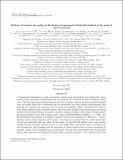Por favor, use este identificador para citar o enlazar a este item:
http://hdl.handle.net/10261/236841COMPARTIR / EXPORTAR:
 SHARE SHARE
 CORE
BASE CORE
BASE
|
|
| Visualizar otros formatos: MARC | Dublin Core | RDF | ORE | MODS | METS | DIDL | DATACITE | |

| Título: | Evidence of runaway gas cooling in the absence of supermassive black hole feedback at the epoch of cluster formation |
Autor: | Hlavacek-Larrondo, Julie; Rhea, C. L.; Webb, T.; McDonald, M.; Muzzin, A.; Wilson, G.; Finner, K.; Valin, F.; Bonaventura, N.; Cooper, M.; Fabian, Andrew C.; Gendron-Marsolais, Marie-Lou; Jee, M.J.; Lidman, C.; Mezcua, Mar CSIC ORCID; Noble, A.; Russell, H. R.; Surace, Jason; Trudeau, A.; Yee, H. K. C. | Fecha de publicación: | 2020 | Editor: | IOP Publishing | Citación: | Astrophysical Journal Letters 898(2): L50 (2020) | Resumen: | Cosmological simulations, as well as mounting evidence from observations, have shown that supermassive black holes play a fundamental role in regulating the formation of stars throughout cosmic time. This has been clearly demonstrated in the case of galaxy clusters in which powerful feedback from the central black hole is preventing the hot intracluster gas from cooling catastrophically, thus reducing the expected star formation rates by orders of magnitude. These conclusions, however, have been almost entirely based on nearby clusters. Based on new Chandra X-ray observations, we present the first observational evidence for massive, runaway cooling occurring in the absence of supermassive black hole feedback in the high-redshift galaxy cluster SpARCS104922.6 + 564032.5 (z = 1.709). The hot intracluster gas appears to be fueling a massive burst of star formation (≈900 M⊙ yr−1) that is offset by dozens of kpc from the central galaxy. The burst is co-spatial with the coolest intracluster gas but not associated with any galaxy in the cluster. In less than 100 million years, such runaway cooling can form the same amount of stars as in the Milky Way. Therefore, intracluster stars are not only produced by tidal stripping and the disruption of cluster galaxies, but can also be produced by runaway cooling of hot intracluster gas at early times. Overall, these observations show the dramatic impact when supermassive black hole feedback fails to operate in clusters. They indicate that in the highest overdensities, such as clusters and protoclusters, runaway cooling may be a new and important mechanism for fueling massive bursts of star formation in the early universe. | Descripción: | arXiv:2007.15660v1 | Versión del editor: | https://doi.org/10.3847/2041-8213/ab9ca5 | URI: | http://hdl.handle.net/10261/236841 | DOI: | 10.3847/2041-8213/ab9ca5 | E-ISSN: | 2041-8213 |
| Aparece en las colecciones: | (ICE) Artículos |
Ficheros en este ítem:
| Fichero | Descripción | Tamaño | Formato | |
|---|---|---|---|---|
| evideforma.pdf | 1,17 MB | Adobe PDF |  Visualizar/Abrir |
CORE Recommender
SCOPUSTM
Citations
12
checked on 20-abr-2024
WEB OF SCIENCETM
Citations
9
checked on 23-feb-2024
Page view(s)
65
checked on 24-abr-2024
Download(s)
70
checked on 24-abr-2024
Google ScholarTM
Check
Altmetric
Altmetric
NOTA: Los ítems de Digital.CSIC están protegidos por copyright, con todos los derechos reservados, a menos que se indique lo contrario.
